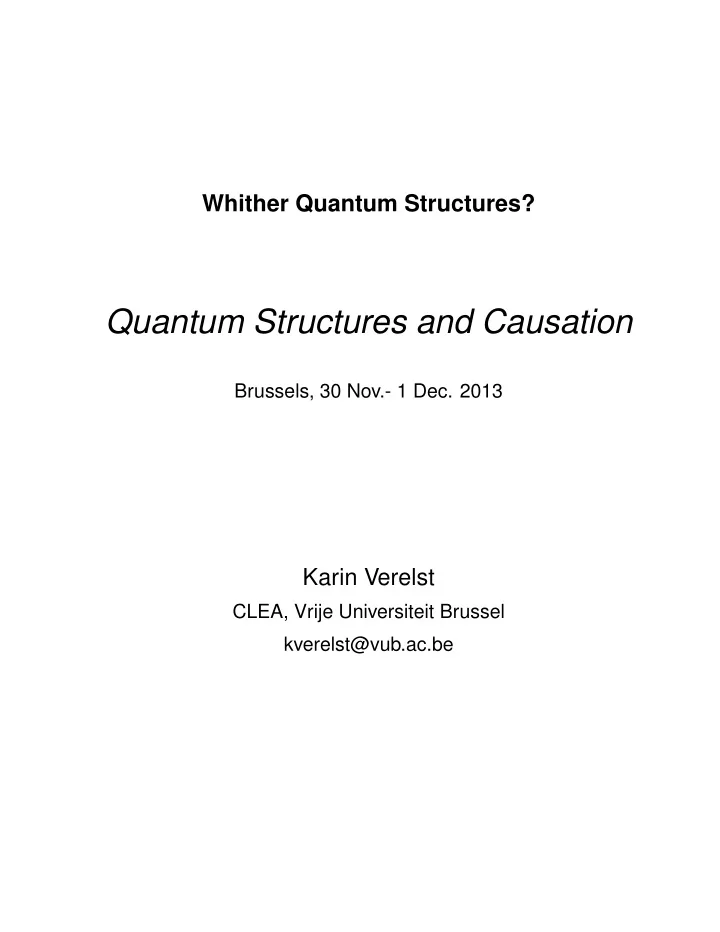

Whither Quantum Structures? Quantum Structures and Causation Brussels, 30 Nov.- 1 Dec. 2013 Karin Verelst CLEA, Vrije Universiteit Brussel kverelst@vub.ac.be
Summary • What can quantum logic do for philosophy? • What can cateogry theory do for philosophy? • Causation • Identity and Causation • Order and Causation • Noether’s Theorem
What can quantum logic do for Philosophy? Birkhoff and Von Neumann (1936): compare the logical structures of physical theories rather than their specific contents in order to understand their differences. Two levels of description for the characterisation of phys- ical systems in general , each equipped with an appro- priate space and a notion of proposition: observational level • observation space := outcome sets for given exper- iments • experimental propositions := certain subsets of the outcome sets which represent statements on the results of specific measurements, to each of which a probability is assigned
state level • state space • propositions := certain subsets of the state space which are related to specific subsets of the out- come sets The problem is to characterise this relation both in the classical and the quantum case. Link to logic: notion of experimental propositions as an- swers to yes/no-questions. Ex.: “does the temperature of the gas lie within a given interval of R+?”). In the quantum case the yes/no-questions correspond to projection operators P , i.e., self-adjoint, idempotent ( P 2 = P ) operators with as spectrum the set { 0 , 1 } , which are in one-to-one correspondence with the closed onedimensional subspaces of H . BVN saw that the connection between observables and projections paves the way for a logical perspective on experimental propositions via the calculus of projec- tions . Their concern with logic arose from the fact that the propositions on the QM-observables of a physical
system do not behave in accordance with the laws of classical logic: distributivity fails. Ontological interpretation of this failure: nature of “state” (superpositions), nature of “system” (whole greater than sum parts), nature of “‘measurement” (incompatible mea- surements)! Remark: Experimental propositions depend a priori only on the measurement apparatus although, in order to be able to set up an experiment, one has to make implicit assumptions on the nature of the system observed. Mackey (1963): lattice theoretical formulation of the cal- culus of projections. Notion of “property lattice”. Fundamental contribution by Piron: - “operational” approach: a set of axioms for QL based on physical considerations; - representation theorem (1964, 1972, 1976), connect- ing the property lattice of the OQL-description to Hilbert space - rigourous definition of “experimental project”: distinc- tion between states, properties and measurement out- comes (“elements of reality” counterfactually defined)
Problems: • only pure states • no lattice-theoretic representation for the tensor prod- uct between Hilbert spaces (compound systems) But we did learn a lot! “(...) it must above all be recognized that, however far quantum effects transcend the scope of classical phys- ical analysis, the account of the experimental arrange- ment and the record of the observations must always be expressed in common language supplemented with the terminology of classical physics.” (N. Bohr, 1948) “(...) pushing this system [a measuring instrument] into the framework of quantum mechanics, one should ad- mit that it is never possible to superpose states cor- responding to different positions of the pointer, for this would contradict the very assumption that one has to do with a measuring instrument. Again, we say that states of such a system are separated by a superselection rule. Of course, when a superselection rule operates
between any two states, thus dismissing entirely super- positions of states, one loses quantum behavior com- pletely and reverts to classical behavior.” (Beltrametti and Casinelli, 1981) Experiments as interventions • Isolation of a part of the world • Preparation of the physical system obtained • Classical reduction: actual measurements Gedanken-example: the Puree-experiment (Verelst, IQSA 2002; IAFE, 2011) : a blindfolded observer digs in the ground and finds a potatoe. In order to find out its prop- erties he subjects it to various treatments (I guide him and hand him the instruments he needs). (‘I’ ≡ suppo- sitions). ✛ ✘ S i (Potatoe) − → S f (mashed potatoes, puree) take it, peel it, cook it, and mash it ✚ ✙ 1) The intervention changes the original system. 2) Its result is such that it can be expressed by means of finitely many logical propositions (yes/no-questions). 3) The final step is in general irreversible! HOWEVER: received experimental practice consists (af- ter standardised repitition) in concluding that S f = S i , i.e., that this part of the world consists of puree!
Recommend
More recommend